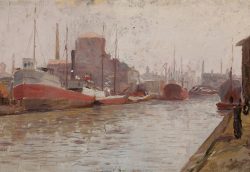James Bolivar Needham 1850–1931
Most of what is now known about James Bolivar Needham is contained in a March 18, 1931, article for the Chicago Daily News written shortly after his death by a reporter who had befriended the elderly artist. It records that Needham, an African American, was born in Chatham, Ontario, Canada, a terminus on the Underground Railroad. Needham’s middle name honoring the colonial Latin American liberator Simon Bolivar probably reflects his family’s aspirations for freedom in the pre-Emancipation era. As boys, Needham and his older brother helped transport livestock between Ontario and Manitoba, and at fourteen James left Chatham to work as a deckhand on cargo vessels sailing the Great Lakes. He arrived in Chicago around 1867 and worked at the Sherman House hotel and then at the Carson Pirie Scott and Company department store, likely as a porter or errand runner.
During construction of the 1893 World’s Columbian Exposition, Needham was employed by one of the many firms charged with decorating the fair’s numerous buildings and extensive grounds. By then, he had begun making the small paintings of the Chicago River and harbor that became his artistic mainstay. How Needham learned to work at the high technical level demonstrated in his earliest paintings remains a mystery. As a person of color he had few opportunities for study or exposure. He probably was largely self-taught by the time that, as has been speculated, he studied informally with sculptor and Art Institute instructor Lorado Taft and with Albert Fleury, who was painting Chicago River scenes by 1898.
Taft was remarkable for his encouragement of women and immigrant artists with little access to established institutions and patrons, and in the mid-1890s, he became something of a champion of Needham. Through the short-lived Central Art Association, which Taft organized in 1894 with writer Hamlin Garland to promote American art in the Midwest, Needham’s Chicago River scenes circulated in at least two separate traveling exhibitions, in 1895 and 1896. According to an 1895 newspaper article about the association’s work, Needham, “the house painter, who for years has been painting pictures of the Chicago River,” had recently been “lionized” locally for his “genius” in discovering the poetic beauties of the polluted Chicago River.i
Needham’s fame was short-lived, however. He spent the remainder of his life in obscurity, painting the river, its structures, and its vessels while supporting himself as a janitor and caretaker. He was working in the latter capacity for the Lambert Tree estate on the Near North Side when a fire in his studio destroyed many of his paintings and caused the lung damage that ultimately took his life. An artistic outsider, Needham sold few paintings, and he may not have exhibited publicly after the mid-1890s. No doubt because he painted chiefly for his own pleasure rather than for exhibition or sale, he rarely signed his works, although he often inscribed the backs with the date of execution and other information. Needham’s paintings have only recently begun to attract awareness, stimulating renewed interest in the artist and admiration for his works.
Wendy Greenhouse, PhD
i “Help’s [sic] Develop Art,” Inter Ocean, undated newspaper clipping (probably spring 1895) in Lorado Taft Papers, University of Illinois Archives.



